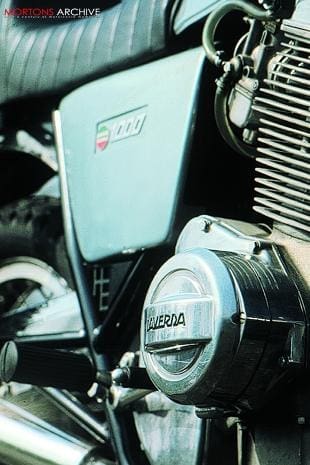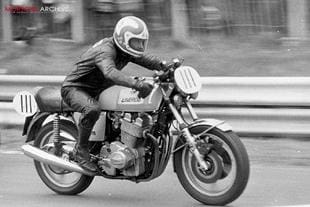
When the fastest of modern sports bikes are capable of nudging 200mph flat out – with brave testers equally capable of pushing them to their limits – it might sound absurd to recall that it wasn’t so long ago that 140mph was a speed beyond the wildest dreams of road riders.
But it was just 25 years ago. The best road bikes, Kawasaki’s Z900 being the leader of the pack, were starting to nudge 130mph at a time when high speed was out of fashion in the wake of the Yom Kippur war in the Middle East and rocketing fuel prices.
Then Laverda came along and knocked everyone to their senses. The little factory in northern Italy had been making limited numbers of a three-cylinder 981cc muscle machine, the 3C. It made its mark, however, when UK importer Slater Brothers decided to breath on the bike as a means of grabbing glory in the nascent Avon Roadrunner production bike race series.
Launched in 1973, the 3C was far more than one of Laverda’s 750cc SF twins with an extra cylinder. Although such an ohc triple prototype had been produced in 1969, the machine commercialised by the brothers Massimo and Piero Laverda featured double overhead camshafts and brutally elegant styling resulting from a huge headlamp and three exhaust pipes tucked under the crankcases to provide excellent (for the time) cornering clearance.
 Performance oozed from the bike and it sounded much more aggressive than its emasculated Japanese counterparts because of the novel 180-degree crankshaft arrangement – the middle piston was at top-dead-centre when the outers were at bottom-dead-centre. It barked its supremacy shamelessly.
Performance oozed from the bike and it sounded much more aggressive than its emasculated Japanese counterparts because of the novel 180-degree crankshaft arrangement – the middle piston was at top-dead-centre when the outers were at bottom-dead-centre. It barked its supremacy shamelessly.
In those days factory launches in sunny resorts or on race tracks were still very rare events. Chances are that Laverda’s motorcycle business (a sideline from its agricultural equipment) couldn’t afford it. So the first of the 3C triples I could get my hands on as a tester for the weekly Motor Cycle newspaper was provided by Essex dealer Ongar Motorcycles six months after its Italian debut.
That bike, however, established a reputation that would remain with the marque forever. Big and brutal, the 3C was a bike for hard riders who didn’t care that performance had to be suffered for with heavy controls and stiff suspension. Novel too were the adjustable footrests and clip-on handlebars, and an optional race style seat. Looks alone were enough to sell it.
Performance figures
When I took the bike to MIRA’s proving ground on a misty and cool April day in 1974, great things were expected. As the performance figures show, it took a while for me to get used to the bike’s top end and how the brakes would respond to repeated flat-out stops. Unlike the debut machines that featured huge ventilated drums, the Ongar machine came equipped with dual Brembo front discs to complement the rear drum.
After a few runs at just over 125mph they were clearly up to the task, so I wound the engine to its 7500rpm red line and it topped 130mph. But with a strong headwind in the opposite direction the best the bike could manage was under 126mph for a mean two-way figure of 128.46mph. So Kawasaki’s Z900 was still the king with a average 131mph. Extra performance was necessary to humble the big Kawasaki so Slaters decided to collaborate with the factory and homologate a more potent model for the following season.
 Called the 3C-E (E for English market), it came with a special exhaust system made in the UK with larger outlets from the twin tailpipes. Rear wheel power was lifted from 68 to 75bhp said Roger Slater and although the exhaust, as I wrote at the time ‘chimed into a screaming wail’ at the peak revs of 8000rpm, it was legal in the UK.
Called the 3C-E (E for English market), it came with a special exhaust system made in the UK with larger outlets from the twin tailpipes. Rear wheel power was lifted from 68 to 75bhp said Roger Slater and although the exhaust, as I wrote at the time ‘chimed into a screaming wail’ at the peak revs of 8000rpm, it was legal in the UK.
Slaters provided a test bike for MIRA testing in 1975 and suspecting that the additional power might result in over-revving in top gear, fitted a 38-tooth rear sprocket to replace the standard 40-tooth item, raising the gearing to give an estimated 140mph at 7600rpm in top.
If I’d thought that the previous year’s bike was a hairy proposition, the 3C-E was altogether more daunting. Today’s machines with their superior aerodynamics require the rider simply to tuck inside the fairing. On the 3C-E I was hanging on in a hurricane and the slightest relaxation could lop several miles an hour off the speed. By the time I’d thundered half way down the 1300 yard timing strip, the bike was clocking 120mph and I changed up from fourth to top gear. It felt, as I wrote soon after “like riding a raging bull along a tightrope.”
Downhill and with a tail wind, the bike clocked two runs at 139.64 and 139.80mph and with a best return speed into the wind of just under 127mph the mean of the two highest speeds was 133.30mph, enough to beat the Kawasaki. If I’d thought that it would clock more that 140mph I wasn’t about to try, or was able to. Attempting full-bore standing quarter mile acceleration tests was more than the clutch could take.
The taller gearing demanded no small degree of slipping to get the 522-pound bike smartly away from a standstill and started to fail. But not until the bike had clocked 12.7 seconds with a terminal speed of 108mph: the Laverda had grabbed the garland. The more potent top-end potential also exposed a weakness in the chassis. Though taut, lithe and stable most of the time, it would get flighty at more than 130mph – a characteristic that was corrected for racing by using a larger rear Dunlop Endurance KR91 tyre on a wider 2.5in rim and fitting SFC front fork yokes that offered more trail than the standard 5.5in.
 New-found celebrity
New-found celebrity
To mark the Laverda triple’s new-found celebrity, it was decided to provide the bike with a name; Jota, an Italian dance in triple time, was chosen for the following 1976 model year.
Although joined in the range by the more docile 1200 triple with an 1116cc engine, the Jota was Laverda’s most powerful machine and became a classic straight from the factory.
Like every good performance machine with racing connections, the Jota was offered with a number of additional options over the 3C-E. The ‘works’ production racer campaigned by Peter Davies had everything from the book and was tested in August 1976 at MIRA in (recorded by the late Bob Currie in the timing hut) ‘nice’ conditions.
To improve on the earlier bike, camshafts were different and better tuned to the exhaust system, while the air filter was removed and the carburation adjusted accordingly. Visible new features on the bike were five-spoke cast-alloy wheels, a disc rear brake and a stylish fold-up seat. For racing, Laverda offered a modified gearbox with closer ratios and this was used in the test bike. It meant that better use could be made of the more peaky power band, but with an 18 percent higher bottom gear, it was very awkward to ride in town.
Strangely, the Nippon Denso rev meter’s red line was always marked from 7500 to 8500rpm; in fact the Laverda triple barked out its maximum 90bhp (at the crank) at 7600rpm and Slater said it was safe to 8500rpm.
Timing straight
Just in case Slater’s baby didn’t perform just as they hoped, Richard Slater, brother of Roger, accompanied us to the timing straight as an ‘assistant’, a scam that was, as a rule, strictly out of bounds. As I recall, we started by raising the overall gearing to match the 3C-E with a 38-tooth rear sprocket but it was too high for the narrower power band to pull, so we switched back to the standard gearing and the bike reeled off a series of hot runs, none of which were less than 132mph but culminated in a best one way of 140.04mph.
 It wasn’t, strictly speaking, a ‘mean’ top speed according to the way we measured such things at Motor Cycle, but the big Laverda had been recorded at more than 140mph, the first time that a commercially-available road bike had reached such a speed under test conditions. It was enough.
It wasn’t, strictly speaking, a ‘mean’ top speed according to the way we measured such things at Motor Cycle, but the big Laverda had been recorded at more than 140mph, the first time that a commercially-available road bike had reached such a speed under test conditions. It was enough.
Production racing bikes on tall gearing rarely prove to be much good at drag racing, for which the machine should be set up for quick getaways and low-speed acceleration. And so it proved with this particular Jota. I managed just three quarter-mile sprints before the clutch gave up the ghost. Once the bike got going it flew, with a terminal speed of more than 110mph. This was much higher than the Kawasaki’s speed but the quarter mile time was slower by half a second at 13.05s. The tall bottom gear, good for 64mph, and the need for clutch slipping, proved too much for the friction plates, despite them being changed at the strip. The mean top speed of 137.76mph put the bike out of the reach of the Kawasaki and many other machines for two years, until the debut of better handling and more powerful Japanese machines like the Suzuki GS1000. It was the first glorious era of Italian motorcycles. The Jota will live on forever as a testimony to that period. View original article



